Input interpretation

sucrose
Chemical names and formulas
![formula | C_12H_22O_11 name | sucrose IUPAC name | (2R, 3S, 4S, 5S, 6R)-2-[(2S, 3S, 4S, 5R)-3, 4-dihydroxy-2, 5-bis(hydroxymethyl)oxolan-2-yl]oxy-6-(hydroxymethyl)oxane-3, 4, 5-triol alternate names | beet sugar | cane sugar | saccharose | table sugar mass fractions | C (carbon) 42.1% | H (hydrogen) 6.48% | O (oxygen) 51.4%](../image_source/8d8b9efd24296e64f1cad778554a23ad.png)
formula | C_12H_22O_11 name | sucrose IUPAC name | (2R, 3S, 4S, 5S, 6R)-2-[(2S, 3S, 4S, 5R)-3, 4-dihydroxy-2, 5-bis(hydroxymethyl)oxolan-2-yl]oxy-6-(hydroxymethyl)oxane-3, 4, 5-triol alternate names | beet sugar | cane sugar | saccharose | table sugar mass fractions | C (carbon) 42.1% | H (hydrogen) 6.48% | O (oxygen) 51.4%
Lewis structure
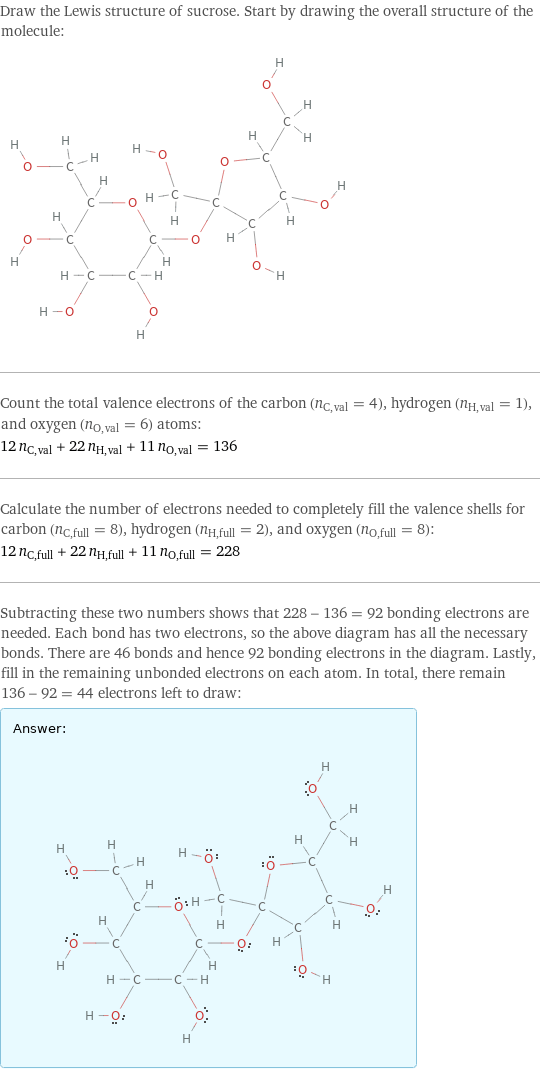
Draw the Lewis structure of sucrose. Start by drawing the overall structure of the molecule: Count the total valence electrons of the carbon (n_C, val = 4), hydrogen (n_H, val = 1), and oxygen (n_O, val = 6) atoms: 12 n_C, val + 22 n_H, val + 11 n_O, val = 136 Calculate the number of electrons needed to completely fill the valence shells for carbon (n_C, full = 8), hydrogen (n_H, full = 2), and oxygen (n_O, full = 8): 12 n_C, full + 22 n_H, full + 11 n_O, full = 228 Subtracting these two numbers shows that 228 - 136 = 92 bonding electrons are needed. Each bond has two electrons, so the above diagram has all the necessary bonds. There are 46 bonds and hence 92 bonding electrons in the diagram. Lastly, fill in the remaining unbonded electrons on each atom. In total, there remain 136 - 92 = 44 electrons left to draw: Answer: | |
3D structure
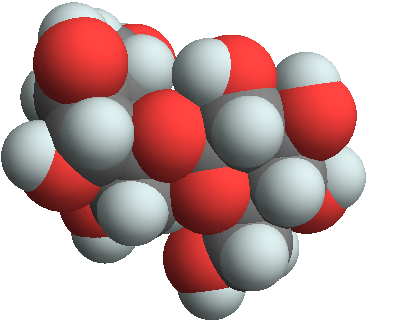
3D structure
Basic properties
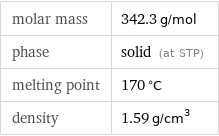
molar mass | 342.3 g/mol phase | solid (at STP) melting point | 170 °C density | 1.59 g/cm^3
Units

Hydrophobicity and permeability properties

experimental LogP hydrophobicity | -3.7 predicted LogP hydrophobicity | -2.63 predicted LogS | 0.38 experimental Caco-2 permeability | -5.77
Basic drug properties

approval status | experimental | small molecule drug categories | sweetening agent
Solid properties (at STP)

density | 1.59 g/cm^3 vapor pressure | 2×10^-22 mmHg (at 25 °C) refractive index | 1.5376
Units

Thermodynamic properties
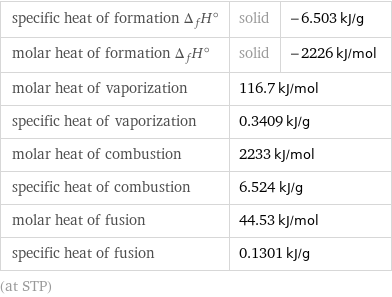
specific heat of formation Δ_fH° | solid | -6.503 kJ/g molar heat of formation Δ_fH° | solid | -2226 kJ/mol molar heat of vaporization | 116.7 kJ/mol | specific heat of vaporization | 0.3409 kJ/g | molar heat of combustion | 2233 kJ/mol | specific heat of combustion | 6.524 kJ/g | molar heat of fusion | 44.53 kJ/mol | specific heat of fusion | 0.1301 kJ/g | (at STP)
Chemical identifiers

CAS number | 57-50-1 Beilstein number | 90825 PubChem CID number | 7566553 PubChem SID number | 3389 SMILES identifier | C(C1C(C(C(C(O1)OC2(C(C(C(O2)CO)O)O)CO)O)O)O)O InChI identifier | InChI=1/C12H22O11/c13-1-4-6(16)8(18)9(19)11(21-4)23-12(3-15)10(20)7(17)5(2-14)22-12/h4-11, 13-20H, 1-3H2/t4-, 5-, 6-, 7-, 8+, 9+, 10+, 11-, 12+/m1/s1 InChI key | CZMRCDWAGMRECN-UHFFFAOYAQ EU number | 200-334-9 RTECS number | WN6500000 NSC number | 406942
NFPA label

NFPA label
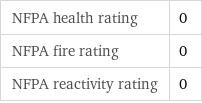
NFPA health rating | 0 NFPA fire rating | 0 NFPA reactivity rating | 0
Toxicity properties

lethal dosage | 29700 mg/kg (oral dose for rats) short-term exposure limit | 20 mg/m^3

probable lethal dose for man | 1 L (liter) long-term exposure limit | 10 mg/m^3 (over 8 hours) RTECS classes | mutagen | reproductive effector